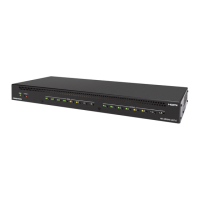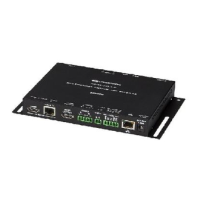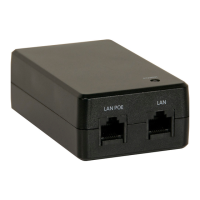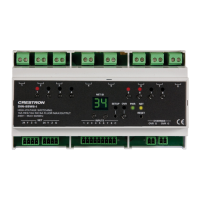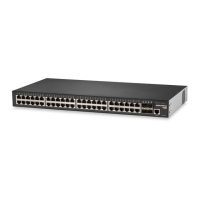Do you have a question about the Crestron HD-MD4X2-4KZ-E and is the answer not in the manual?
Explains the web interface for status and configuration of AV switchers.
Details how to access the web interface via browser or Toolbox.
Steps to access the web interface using a web browser.
Steps to access the web interface via the Crestron Toolbox application.
Procedure to reboot the AV switchers to apply settings.
Steps to restore AV switchers to their original factory settings.
Guide on how to update AV switchers' firmware.
Instructions for downloading log files from the AV switchers.
Process for adding, removing, and managing certificates for 802.1x.
Steps to add certificates to the AV switcher.
Steps to delete certificates from the AV switcher.
Dialog to load and manage custom EDID files.
Procedure to load a custom EDID file.
Steps to delete a custom EDID file.
Process to download the current configuration.
Steps to upload a configuration file.
Displays model, serial number, and firmware version.
Information on inputs and outputs, including sync and HDCP status.
Details about each input source, sync, resolution, and HDCP.
Details about each output, including sink connection and HDCP.
Displays network settings like Host Name, IP Address, Subnet Mask.
Shows connection information for the control system.
Contains settings for Network, Front Panel, Cloud, Date/Time, etc.
Configuration for network settings like DHCP and IP address.
Steps to enable/disable DHCP and configure network parameters.
Settings to lock front panel buttons and control LEDs.
Options to enable/disable cloud configuration service connection.
Configuration for automatic firmware updates.
Settings for configuring date, time, and time synchronization.
How to enable/disable time sync and configure NTP servers.
Steps to set Time Zone, Date, and Time.
Configuration for control system connection and encryption.
How to enable/disable the USB service port.
Setting a default EDID for all inputs.
Configuring individual input settings like name, EDID, and HDCP.
Detailed steps to edit HDMI input configurations.
Configuration for AUX output volume, mute, and stereo.
Configuration for HDMI output settings.
Settings for HDMI output, including disabling, blanking, and HDCP.
Settings for automatic and priority-based input routing.
Information about the connected display device.
Details on transmitting, resolution, and HDCP status of the output signal.
Settings for audio output, including HDMI mute.
Setup for automatic display power management.
Enables or disables automatic routing of video inputs.
Enables or disables routing the same input to multiple outputs.
Sets priority levels for automatic input routing.
Routes a single input to all outputs.
Manually routes an input to an output.
View and change password for the current user.
View and edit user settings, add/remove users.
Steps to create a new local user account.
How to grant access to an existing Active Directory user.
Process to delete a user account.
View detailed information about a selected user.
Steps to update user details.
View and edit group settings, add/remove groups.
Steps to create a new local group.
How to grant access to an existing Active Directory group.
Process to delete a group.
View detailed information about a selected group.
Steps to configure 802.1X authentication for network security.
Explains the web interface for status and configuration of AV switchers.
Details how to access the web interface via browser or Toolbox.
Steps to access the web interface using a web browser.
Steps to access the web interface via the Crestron Toolbox application.
Procedure to reboot the AV switchers to apply settings.
Steps to restore AV switchers to their original factory settings.
Guide on how to update AV switchers' firmware.
Instructions for downloading log files from the AV switchers.
Process for adding, removing, and managing certificates for 802.1x.
Steps to add certificates to the AV switcher.
Steps to delete certificates from the AV switcher.
Dialog to load and manage custom EDID files.
Procedure to load a custom EDID file.
Steps to delete a custom EDID file.
Process to download the current configuration.
Steps to upload a configuration file.
Displays model, serial number, and firmware version.
Information on inputs and outputs, including sync and HDCP status.
Details about each input source, sync, resolution, and HDCP.
Details about each output, including sink connection and HDCP.
Displays network settings like Host Name, IP Address, Subnet Mask.
Shows connection information for the control system.
Contains settings for Network, Front Panel, Cloud, Date/Time, etc.
Configuration for network settings like DHCP and IP address.
Steps to enable/disable DHCP and configure network parameters.
Settings to lock front panel buttons and control LEDs.
Options to enable/disable cloud configuration service connection.
Configuration for automatic firmware updates.
Settings for configuring date, time, and time synchronization.
How to enable/disable time sync and configure NTP servers.
Steps to set Time Zone, Date, and Time.
Configuration for control system connection and encryption.
How to enable/disable the USB service port.
Setting a default EDID for all inputs.
Configuring individual input settings like name, EDID, and HDCP.
Detailed steps to edit HDMI input configurations.
Configuration for AUX output volume, mute, and stereo.
Configuration for HDMI output settings.
Settings for HDMI output, including disabling, blanking, and HDCP.
Settings for automatic and priority-based input routing.
Information about the connected display device.
Details on transmitting, resolution, and HDCP status of the output signal.
Settings for audio output, including HDMI mute.
Setup for automatic display power management.
Enables or disables automatic routing of video inputs.
Enables or disables routing the same input to multiple outputs.
Sets priority levels for automatic input routing.
Routes a single input to all outputs.
Manually routes an input to an output.
View and change password for the current user.
View and edit user settings, add/remove users.
Steps to create a new local user account.
How to grant access to an existing Active Directory user.
Process to delete a user account.
View detailed information about a selected user.
Steps to update user details.
View and edit group settings, add/remove groups.
Steps to create a new local group.
How to grant access to an existing Active Directory group.
Process to delete a group.
View detailed information about a selected group.
Steps to configure 802.1X authentication for network security.
| Model | HD-MD4X2-4KZ-E |
|---|---|
| Input Ports | 4 |
| Output Ports | 2 |
| HDCP Support | HDCP 2.2 |
| HDMI Version | 2.0 |
| Control | IR, RS-232, Ethernet |
| Ethernet | Yes |
| EDID Management | Yes |
| Type | HDMI Switch |
| Max Resolution | 4K@60Hz |
| HDR | HDR10 |
| Audio Format | Dolby Digital, DTS |




